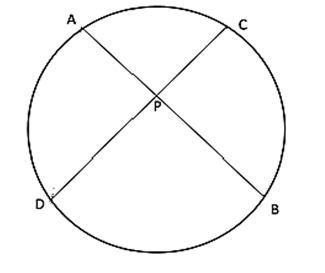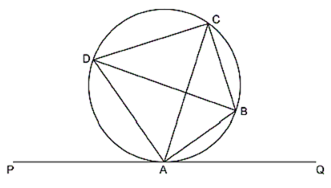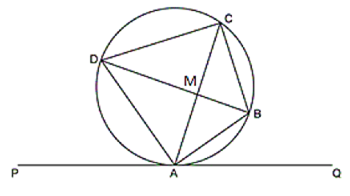In the figure given below, diameter AB and chord CD of a circle meet at P. PT is a tangent to the circle at T. CD = 7.8 cm, PD = 5 cm, PB = 4 cm. Find:
(i) AB.
(ii) the length of tangent PT.

We know that, Product of the lengths of the segments of the chord is equal to the square of the length of the tangent from the point of contact to the point of intersection.

(i) As chord CD and tangent at point T intersect each other at P,
PC PD = PT2 ...(i)
AB is the diameter and tangent at point T intersect each other at P,
PA × PB = PT2 .(ii)
From (i) and (ii), PC × PD = PA × PB …(iii)
Given: PD = 5cm, CD = 7.8cm
PA = PB + AB
= 4 + AB
And, PC = PD + CD
= 12.8cm
By substituting these values in equation (iii),
12.8 5 = (4 + AB) 4
(ii) PC PD = PT2
PT = 8cm
Therefore, the length of tangent is 8cm.
In the figure given below, ABCD is a rectangle. AB = 14 cm, BC = 7 cm.
From the rectangle, a quarter circle BFEC and a semicircle DGE are removed.
Calculate the area of the remaining piece of the rectangle. (Take π = 22/7)

Considering the given figure,

Given dimensions of the rectangle: AB = 14 cm and BC = 7 cm
Therefore, radius of quarter circle =
=
= sq.cm
Now, area of rectangle ABCD = AB BC = 14 7 = 98 sq. cm
Required area = Area of rectangle ABCD - [Area of (BCEF) - Area of (DGE)]
=
=
= 40.25 sq. cm
AB and CD are two chords of a circle intersecting at P. Prove that .

Construction : As given, we have to join AD and CB

InAPD and CPB
We can write,
( Angles are in same segment)
( Angles are in same segment)
By AA Postulate,
( Corrosponding sides of similar triangles)
Hence proved.
In the given figure PQ is a tangent to the circle at A, AB and AD are bisectors of , prove that:
(i) BD is a diameter of the circle
(ii) ABC is an isosceles triangle


S0, BD is the diameter of the circle.
( ii ) Since BD is the diameter of the circle, so it will pass through the centre.
By Alternate segment theorem,
We know that perpendicular drawn from the centre to a chord of a circle bisects the chord.
